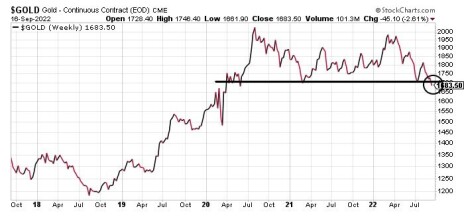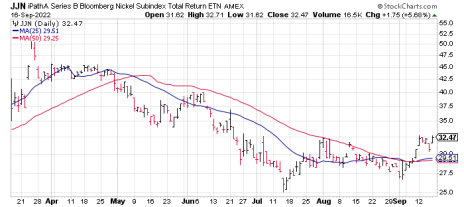Gold and Recession Risk
One of the most aggressive Federal Reserve rate-hiking cycles ever is weighing heavily on gold, with another rate increase expected this week. On top of that, continued strength in the dollar index and rising yields in longer-term Treasuries (a major competitor for gold) are causing bullion investors to run for the exits.
Last week, the yellow metal closed at a two-year low—the first time this has happened since gold’s bull market began in 2018. While at first glance this may not appear to be a watershed event, statistical studies conducted by Dean Christians indicate that whenever this has happened in the past, gold (along with gold mining stocks) has been lower six months later without a single exception going all the way back to 1976.
There is, of course, a danger in hanging one’s hat on such sterile studies—especially where the dynamic gold market is concerned. But it’s definitely something to keep in mind as the bear market in gold grinds on. The market certainly hasn’t provided us with a compelling reason in recent months for stepping in as buyers. And barring a strong reversal in the dollar index or the 10-year Treasury bond yield, we’re not likely to get one anytime soon.
Where gold’s bear market might finally reach a terminus, however, is if the U.S. economy enters a recession. Gold prices typically trend inversely to the state of the economy, with a persistently rising gold price often coinciding with economic weakness, while a falling price frequently denotes economic strength. (Expressed another way, if we assume that a currency is a barometer of a nation’s economic strength, a strong dollar normally means lower gold prices while a weak dollar usually benefits gold.)
And what could serve as a catalyst for the next recession? One answer was recently provided by University of Chicago economist Austan Goolsbe, who told NPR’s Weekend Edition:
“We’ve had 13 or 14 recessions since World War II, and more than two-thirds of those recessions were caused by the Fed raising the interest rate faster than the economy can handle.”
Many economists believe the Fed’s continued rate increases could eventually serve to weaken the economy, possibly even pushing it into recession if it continues. If there is a recession, gold would almost certainly benefit—just as it did in the last two recessions in 2008 and 2020. In a recession, Treasury yields would presumably decline, thereby making non-yielding gold more attractive to safety-oriented investors.
Moreover, a weaker economy would likely force the Fed to intervene by injecting liquidity into it, which would help lower the dollar’s value and thereby increase the gold price (since gold is inversely correlated to the currency).
Speaking of recession risk, a widely publicized statement by the CEO of FedEx (FDX), Raj Subramaniam, made headlines last week while rattling the financial market. Prompted by CNBC’s Jim Cramer, who suggested we could be entering a “worldwide recession,” Sabramaniam agreed and blamed his company’s poor earnings outlook on soft economic conditions. FedEx also cut its third-quarter sales forecast by half a billion dollars, which spurred a big sell-off in the company’s stock.
FedEx said it’s seeing a decline in freight volume globally, led by weakness in Asia, adding that U.S. consumers are being shielded to some extent by the dollar’s strength, which is boosting their purchasing power. However, the FedEx CEO added he’s also seeing a slowdown in America’s spending.
With these factors in mind, a recession is becoming an increasing possibility in the months ahead—and it might just take this extremity to push gold out of its current malaise. But until that happens, the path of least resistance for the precious metal is likely to be lower. For that reason, I recommend a continued defensive stance where gold and the other major precious metals are concerned.
Updates
New addition: Buy a Half of the iPath Series B Bloomberg Nickel Subindex Total Return ETN (JJN)
Alliance Resource Partners (ARLP) is a producer of metallurgical coal (for the steelmaking industry) and thermal coal (for electrical utilities), with approximately two billion tons of coal reserves in several U.S. midwestern and southern states. Alliance is currently the second-largest coal producer in the eastern U.S. with additional mineral and royalty interests in the highly productive Permian, Anadarko and Williston basins. (The company markets its mineral interests for lease to operators in those regions and generates royalty income from the leasing and development of those mineral interests.) Management indicated that coal operations have delivered “significant” year-over-year per ton margin expansion, adding that it sees ARLP well positioned to see further margin growth in 2023 and 2024. While metallurgical coal demand is weakening due to softer global economic conditions, thermal coal demand is expected to remain supported going forward by lower exports from major suppliers like Australia (more than 50% of met coal supply) and Russia as more countries turn to coal to meet an energy crisis brought on by natural gas shortages. On a technical note, I suggest raising the stop-loss on the remaining position (after our recent profit-taking move) to slightly under 23 on a closing basis, where the 50-day line currently resides. HOLD A HALF
Our recent examination of the copper/gold ratio revealed that copper tends to rally when the ratio falls under 0.19, which it did recently. A 14-year statistical survey further shows that in every case without exception, copper posted a meaningful price gain (i.e. between 30% and 50%) in the six-to-12 months following the signal. With that in mind, participants who don’t mind the short-term volatility risk recently purchased a conservative position in the Global X Copper Miners ETF (COPX) using a level slightly under 28 as the initial stop-loss on a closing basis. BUY A HALF
Participants recently purchased a conservative position in the Global X Uranium ETF (URA) using a level slightly under 19.50 as the initial stop-loss on a closing basis. After the recent 13% rally, I suggested taking 50% profit last week and raising the protective stop to slightly under 22 on a closing basis on the remaining position. We were subsequently stopped out of the remaining half of this position on September 16 after this level was violated. Given the relative technical and fundamental strength of uranium, I may end up regretting using such a conservative stop-loss for our position in URA. However, with the broad market as internally weak as it has been in recent weeks, I believe that it’s better to be safe than sorry. That said, if the market firms up in the coming days I’ll certainly give URA another look as this ETF is a prime candidate for outperforming in a stronger market environment. SOLD
Nickel prices recently jumped 12% after major producer Vale SA (VALE) announced plans to unlock value at its nickel and copper division. The industry is getting an additional sentiment boost from the commencement of peak construction season in China. Since bottoming on July 15, nickel futures have risen more than 20% as Vale increased its nickel output guidance, prompting a major Wall Street bank to estimate the company’s plans could unlock as much as $13 billion. Vale sees a 44% increase in global nickel demand by 2030, driven mainly by batteries that power electric vehicles. Accordingly, I’m putting my favorite nickel-tracking vehicle, the iPath Series B Bloomberg Nickel Subindex Total Return ETN (JJN), back on a buy. Participants can purchase a conservative position in JJN using a level slightly under 30 as the initial stop-loss on a closing basis. BUY A HALF
While gold remains in the doldrums, white metals—particularly palladium—are holding their own relative to the yellow metal. And while I’m not yet ready to pull the trigger on our favorite platinum/palladium ETF, I’m keeping a close watch on one of the biggest stocks in this segment, Platinum Group Metals (PLG). The South African-based company is focused on platinum and palladium production and operates the Waterberg large-scale platinum group metal (PGM) resource, which has an attractive risk profile given its shallow nature. The project also has the potential to be one of the lowest-cost operations in the PGM sector. An even bigger attraction for the company right now, however, is its partnership with Anglo American Platinum (ANGPY). The two companies have created Lion Battery Technologies to support the use of palladium and platinum in lithium battery applications. Lion has entered into an agreement with Florida International University to further advance a research program that uses platinum and palladium to unlock the potential of Lithium Oxygen and Lithium Sulfur battery chemistry, which can perform better, by orders of magnitude, than the best-in-class Lithium-ion batteries currently on the market. This new generation of lightweight, powerful batteries has the potential to grow to scale on the back of the attractiveness of electric vehicles (EVs) and the use of lithium batteries in other applications beyond mobility. Given that alternative energy is one of the market’s strongest performing sectors right now, this could position PLG to significantly outperform in the coming quarters. Accordingly, I’m recommending that we purchase a conservative position in PLG if the stock closes above 1.80 (the stock most recently closed at 1.65). BUY A HALF ABOVE 1.80.
| Stock | Price Bought | Date Bought | Price on Sep. 19 | Profit | Rating |
| Alliance Resource Partners (ARLP) | 18.75 | 7/5/22 | 24 | 36% | Hold a Half |
| Global X Copper Miners ETF (COPX) | 30.5 | 8/2/22 | 30 | -1% | Buy a Half |
| Global X Uranium ETF (URA) | 21.2 | 8/24/22 | 21.9 | 13% | Sold |
| iPath Bloomberg Nickel ETN (JJN) | 32.5 | 9/20/22 | 32.5 | 0% | Buy a Half |
Buy means purchase a position at or around current prices.
Buy a Quarter/Half means allocate less of your portfolio to a position than you normally would (due to risk factors).
Hold means maintain existing position; don’t add to it by buying more, but don’t sell.
Sell means to liquidate the entire (or remaining) position.
Sell a Quarter/Half means take partial profits, either 25% or 50%.

